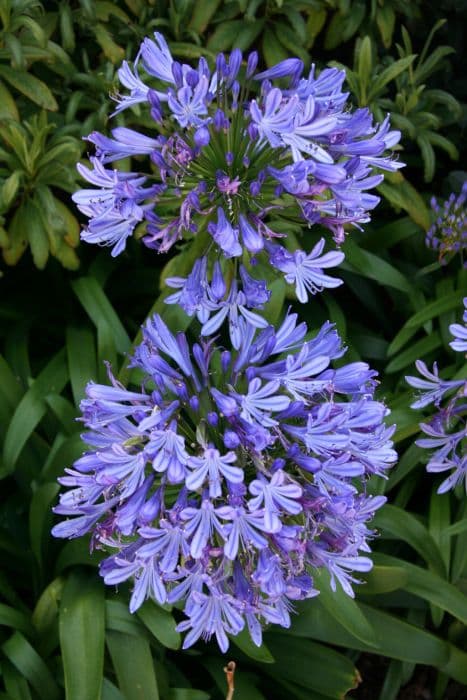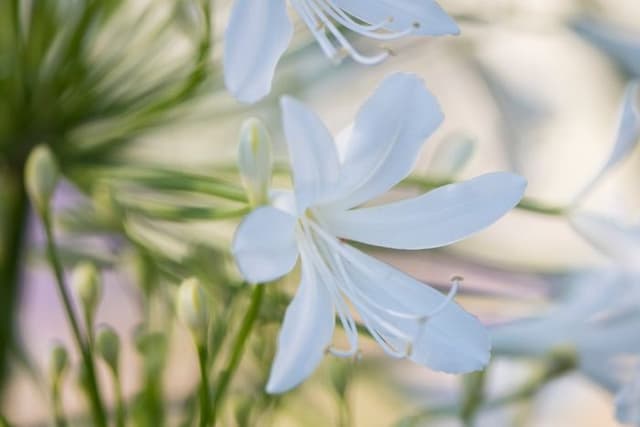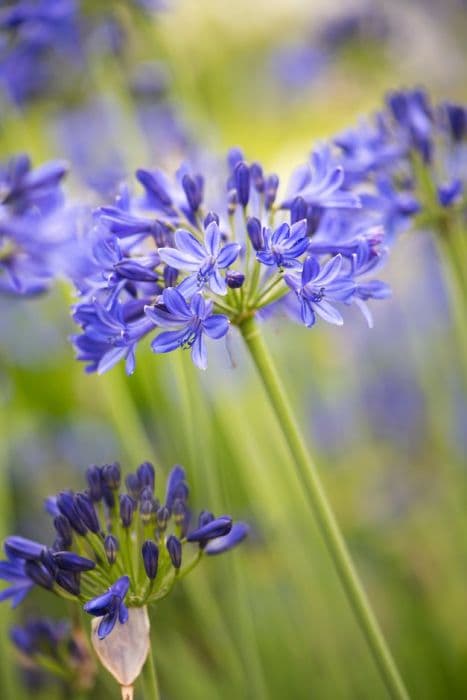African lily 'Ballerina' Agapanthus 'Ballerina'

ABOUT
'Ballerina' is an evergreen perennial to about 1.1m, producing a clump of glossy, strap-shaped, dark green leaves. Light blue, tubular flowers appear in loose, conical clusters in late summer to early autumn
About this plant
 Names
NamesFamily
Amaryllidaceae
Synonyms
African Lily, Lily of the Nile, Love Flower
Common names
Agapanthus 'Ballerina'
 Characteristics
CharacteristicsLife cycle
Perennials
Foliage type
Evergreen
Color of leaves
Green
Flower color
Blue
Height
2 feet (60 cm)
Spread
2 feet (60 cm)
Plant type
Bulb
Hardiness zones
8
Native area
South Africa
Benefits
 General Benefits
General Benefits- Aesthetic Appeal: Adds visual interest to gardens with its elegant, ball-shaped clusters of blue or white flowers on tall stems.
- Low Maintenance: Once established, requires minimal care beyond occasional watering and feeding.
- Drought-Tolerant: Suitable for dry climates or regions with water restrictions, as it can survive periods of low water availability.
- Long Blooming Period: Produces flowers for several weeks in the summer, providing sustained color and interest.
- Attracts Pollinators: Draws in bees, butterflies, and other beneficial insects, which can help pollinate your garden.
- Good Cut Flowers: Long stems and lasting flowers make them ideal for vases and floral arrangements.
- Versatile Planting Options: Can be planted in borders, containers, or as focal points in a garden bed.
- Tolerant of Various Soil Types: Can thrive in different soil conditions, although it prefers well-drained soil.
- Resistant to Pests: Generally not prone to serious pest problems, reducing the need for chemical treatments.
- Deer Resistant: Not typically favored by deer, which helps prevent damage in areas where deer are prevalent.
 Medical Properties
Medical PropertiesThis plant is not used for medical purposes.
 Air-purifying Qualities
Air-purifying QualitiesThis plant is not specifically known for air purifying qualities.
 Other Uses
Other Uses- Agapanthus 'Ballerina' can be used as a natural dye for fabrics, providing a range of colors from soft blues to deep purples depending on the part of the plant used and the dyeing process.
- Ink making is another creative use for Agapanthus, as the sap and flowers can be processed into a vibrant, natural ink for artistic purposes.
- These plants can act as a natural pest deterrent in gardens due to their strong scent that some pests find off-putting.
- They are used in floral art and arrangements, beyond traditional vases, including modern sculptural forms and botanical installations.
- As a teaching tool, Agapanthus is often used in botany and horticulture programs to demonstrate plant structure and reproduction.
- Photographers and painters commonly use the striking blooms of Agapanthus as subjects for their works, celebrating their form and color.
- Agapanthus 'Ballerina' can also function as a natural soil stabilizer thanks to its robust root system, particularly on slopes or banks to prevent erosion.
- The plant's sturdy leaves can be plaited or woven into small handicrafts, similar to basket weaving techniques.
- Gardeners may utilize the dried seed heads of Agapanthus in creating natural, decorative winter garden displays which provide visual interest during the colder months.
- Lastly, Agapanthus can play a role in companion planting, benefiting nearby plants by attracting beneficial insects or providing partial shade to those that require it.
Interesting Facts
 Feng Shui
Feng ShuiThe plant_name is not used in Feng Shui practice.
 Zodiac Sign Compitability
Zodiac Sign CompitabilityThe plant_name is not used in astrology practice.
 Plant Symbolism
Plant Symbolism- Love Letters: Derived from Greek (agape means love, anthos means flower), Agapanthus, commonly known as African Lily, is often associated with love and can symbolize a love letter or message.
- Beauty: The elegant and beautiful blooms of the African Lily can symbolize beauty, making it a popular choice in gardens and as a motif in art and decoration.
- Fertility: In some cultures, the African Lily is believed to represent fertility and creation, due to its lush and bountiful flowering habit.
- Strength: The sturdy stems that hold up the heavy flower heads can symbolize strength and resilience.
- Endurance: The African Lily is known for its ability to survive in harsh conditions, symbolizing endurance and the ability to overcome challenges.
 Water
WaterThe Lily of the Nile should be watered deeply but infrequently, allowing the soil to dry out somewhat between waterings. During the growing season, watering once a week with about one to two gallons per plant is generally sufficient, depending on your local climate and soil conditions. During hot, dry periods, you may need to water more frequently to keep the soil from drying out completely. Cut back on watering in the fall to encourage dormancy, and during winter, water lightly every few weeks only if there has been no significant rainfall.
 Light
LightLily of the Nile thrives in full sun, but it can also tolerate partial shade. The ideal spot would receive at least six hours of direct sunlight per day. However, if you live in an area with very hot summers, providing some afternoon shade will help protect the plant from scorching.
 Temperature
TemperatureLily of the Nile grows best in temperatures between 50°F and 90°F. They can survive brief dips down to about 20°F, but sustained cold below this temperature can damage or kill the plant. The ideal growing conditions for this plant are in areas with warm summers and mild winters.
 Pruning
PruningPruning Lily of the Nile is mainly for aesthetic purposes and to remove spent flowers or dead foliage. Cut back flower stalks after blooms fade to encourage neatness and possibly a second bloom. Pruning is best done in late winter or early spring before the onset of new growth.
 Cleaning
CleaningAs needed
 Soil
SoilAgapanthus, commonly known as African Lily, thrives best in fertile, well-draining soil with a slightly acidic to neutral pH of approximately 6.0 to 7.0. A mixture of garden soil, compost or well-rotted manure, and some perlite or sand can create an ideal environment for 'Ballerina'. This soil mix will support its lush foliage and striking blue flowers, providing adequate nutrients and drainage.
 Repotting
RepottingAfrican Lilies, like Agapanthus 'Ballerina', should generally be repotted every 3 to 4 years or when they become root-bound. They prefer to be a little crowded, so repotting too frequently is not necessary. However, upgrading the pot size or dividing the plant during repotting can promote more vigorous growth and blooming.
 Humidity & Misting
Humidity & MistingAfrican Lilies, such as the Agapanthus 'Ballerina', are quite adaptable but prefer moderate humidity levels. Ensuring that the environment is not too dry can be beneficial, with a humidity level around 40-60% being suitable for most indoor conditions. They do not require excessively high humidity to thrive.
 Suitable locations
Suitable locationsIndoor
Ensure bright light, well-draining soil, and moderate watering.
Outdoor
Plant in sun, shelter from strong winds, enrich soil, water well.
Hardiness zone
8-11 USDA
 Life cycle
Life cycleAgapanthus 'Ballerina', commonly known as Lily of the Nile, begins its life cycle as a seed which germinates in moist soil conditions, ideally in spring. The seedling emerges, developing roots and foliage as it matures into a vegetative state. Over time, it forms a clump of strap-like leaves and strengthens its root system, which is rhizomatous. As a perennial, Lily of the Nile enters a period of dormancy in the colder months, with growth slowing and above-ground foliage sometimes dying back. Upon return of favorable weather, typically in late spring or early summer, it enters the flowering stage where it produces tall stalks topped with globular clusters of blue or white flowers. After the flowering season, seeds can be produced and dispersed, or the plant can be propagated by division of the rhizomes to continue its cycle.
 Propogation
PropogationPropogation time
Spring-Early Summer
The most popular method of propagating the Agapanthus 'Ballerina', commonly known as Lily of the Nile, is by division. This is best done in the spring or early summer when the plant begins active growth. To propagate by division, carefully lift the clump from the ground using a spade, ensuring you get as much of the root system as possible. Gently separate the clump into smaller sections, each with a portion of roots and shoots, using your hands or a sharp knife. Replant the divisions immediately at the same depth they were growing previously, spacing them about 18 inches (approximately 46 centimeters) apart to allow for ample growth room. Water the new plants thoroughly after planting to help establish them in their new location.









![African lily [Double Diamond]](/_next/image?url=https%3A%2F%2Fplants-admin.emdemapps.com%2Fimages%2Fplants%2F%2Fimages%2F604b558c4357a.png&w=640&q=75)